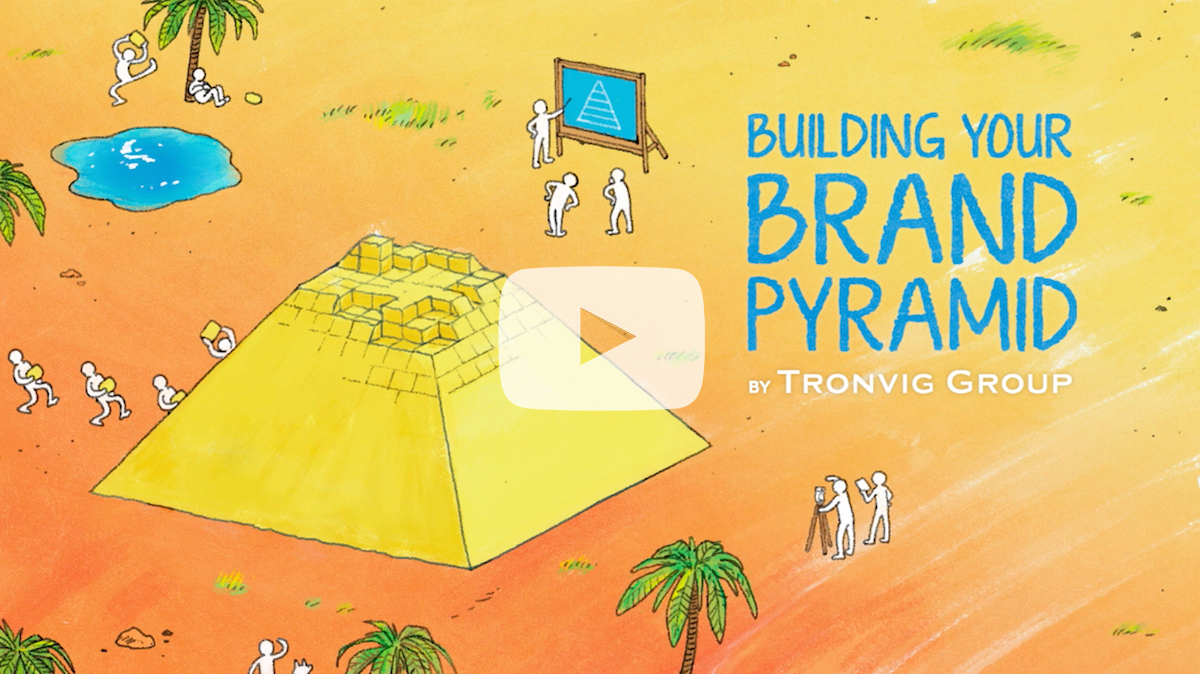What is a brand?
In my strategy workshops, I often ask the seemingly simple question, “What is a brand?” The answers I get are usually focused on how an organization pushes its identity out visually. This is a natural definition. It’s the definition of brand that you typically see expressed in brand guidelines manuals, and it’s a useful definition.
This is visual branding—the stuff an organization uses to communicate its value by visual means. Many branding agencies do visual branding very well. They give the brand personality of an organization a coherent and beautiful visual expression. This is important work. It is not our work, and very often it is not the work that most needs to be done.
Branding
 If I have someone who has studied marketing at the workshop, I usually also get a more expansive definition of branding, something more like, “It is all your points of contact with the world.” After I collect these answers, I either point out how all of them are focused on how an organization pushes out its message, or I draw out the thread in the answers that leads to the biggest definition of a brand, the one that is hardest to control and for which the most work must be done both by the branding agency or consultant and by the organization itself.
If I have someone who has studied marketing at the workshop, I usually also get a more expansive definition of branding, something more like, “It is all your points of contact with the world.” After I collect these answers, I either point out how all of them are focused on how an organization pushes out its message, or I draw out the thread in the answers that leads to the biggest definition of a brand, the one that is hardest to control and for which the most work must be done both by the branding agency or consultant and by the organization itself.
Your brand lives in the minds of your brand consumers. So whatever it is that they retain about you as they go about their lives, whatever it is that they think of when your name is mentioned—that is your brand. At the American Alliance of Museums conference in Atlanta last week, Kristin Prestegaard of the Minneapolis Institute of Arts articulated this in the context of her great visitor-focused museum, “It’s what our visitors say about us.”
So it is not what you say but what they say. This gets at the heart of it. Brands live to the extent that they are coherently diffused out into the world.
How do you achieve coherent diffusion of your Brand Idea? Well, the visual brand is, of course, an important part of this. Getting that solved is often a major project in and of itself and there is a whole industry built around the achievement of that goal.
You can have this visual brand and still have a poorly branded organization.
But that’s only the surface. It’s not even the most important part, difficult as that is to achieve, especially in large complex organizations. It is also slightly dangerous because it’s easy to measure and literally easy to see: If you lay out all your printed materials, all your ads, your website home page, and whatever else you put out into the world and it’s all consistent and coherent, then you’ve done it. Mission accomplished.
But you can have this visual brand and still have a poorly branded organization.
Visual brand example: Colleges
 Colleges and universities typically suffer from this kind of brand failure. They have a strong visual brand (and they spend a lot of money on this) and yet they still have very weak brands. I wrote about college brands after touring some twenty northeastern colleges and universities last summer. The failing is understandable. Most of these institutions are so complex and have such diverse constituencies (prospective students, faculty, alumni, funders), all with differing needs and demands, so it’s no wonder that they just settle for visual consistency. Pushing through to a Brand Idea is just too hard. Too many hard choices are required, and it seems that few in the branding profession are insisting that this happen. This is probably due to the level of difficulty involved, and getting the visual brand right may be regarded by all sides as challenge enough.
Colleges and universities typically suffer from this kind of brand failure. They have a strong visual brand (and they spend a lot of money on this) and yet they still have very weak brands. I wrote about college brands after touring some twenty northeastern colleges and universities last summer. The failing is understandable. Most of these institutions are so complex and have such diverse constituencies (prospective students, faculty, alumni, funders), all with differing needs and demands, so it’s no wonder that they just settle for visual consistency. Pushing through to a Brand Idea is just too hard. Too many hard choices are required, and it seems that few in the branding profession are insisting that this happen. This is probably due to the level of difficulty involved, and getting the visual brand right may be regarded by all sides as challenge enough.
What’s missing?
What’s missing in the college examples, and in nearly all but the most well-branded organizations, is the 360 expression of the brand built around a core set of values (sometimes called attributes). In a 360 brand, the brand lives not only as a product of the marketing and communications function within the organization but as a living, breathing truth in all aspects of organizational life.
The visual brand is not an end in and of itself. It is an expression of a larger brand truth that is scripted into everything from hiring practices to the strategic plan. It is a culture and the culture is expressed through the behavior of every single employee—from CEO to part-time receptionist.
A 360 brand is not only consistent visually but is consistent with itself in all things.
When this is true, and the visual expression of the brand is an accurate reflection of this truth, then the promise made by the brand is fulfilled through the lived experience of the brand. It is fulfilled for all the employees as well as for the visitors, attendees, customers, funders—all the consumers of the brand.
Thus, a truly branded organization—a 360 brand—is not only consistent visually but is consistent with itself in all things. Or at least it is actively working toward the achievement of that goal. This is hard, and it’s much harder to see and measure than the visual brand alone. It is also not usually the responsibility of the marketing and communications department but must be worked on throughout the organization and is thus also an executive function.
This structural impediment is probably the reason it is so rare. Rare is the CEO, and especially the nonprofit CEO, who is able to focus on the change that market reality dictates: You must have both innovation and marketing (writ large, and so including branding) to survive in an always competitive world. Executive, HR, communications/marketing, operations, curatorial—all the components of your complex organization—must work in concert to achieve a 360 brand and doing so will give that organization the power to have its full effect in the world.
This is a question of survival, but also a question of what impact you want to have in the world. Why do you exist? Why do you matter? Why should I care? If you believe your answers to these questions matter—that they have meaning and should be known—then you need more than just a visual brand.
Do you need an affordable way to improve your brand today?
Because we know that not everyone needs or can afford our full process, we created a guided tutorial package for our foundational brand strategy tool: the Brand Pyramid. Watch the video for a preview.
For more information on the brand strategy tutorial, visit here where you will find a fuller explanation and link to a free download of the first video.
Blog illustration for Tronvig Group by Sage Einarsen; Additional image credit: Georgetown Jesuit Residence by Patrickneil, used under CC BY-SA / Saturated and brightened from original



Thanks for consistently eloquent and elegant examination into branding. The pan out into the larger perspective is really helpful…I’m excited to think about my company’s 360 brand now!
Excellent article. Clear and to the point with #addedvalue. Thanks.
Insightful and instructive blogpost, indeed. This is actually first time I have read about the essence of a 360 brand. Thanks!
I am learning how to ‘brand’ my business and research time is precious. This is a well written article, well worth my time to read. Thank you for sharing.
Thank you James for clarifying consistently through your posts the difference between marketing and branding. Great insights and value add. Much appreciated!